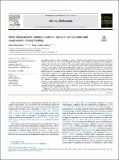Files in this item
Male chimpanzees communicate to mediate competition and cooperation during feeding
Item metadata
| dc.contributor.author | Bouchard, Alice | |
| dc.contributor.author | Zuberbühler, Klaus | |
| dc.date.accessioned | 2022-03-04T18:30:12Z | |
| dc.date.available | 2022-03-04T18:30:12Z | |
| dc.date.issued | 2022-04 | |
| dc.identifier | 278145949 | |
| dc.identifier | dc06e743-b253-4a97-ab10-560f154a1128 | |
| dc.identifier | 85125442664 | |
| dc.identifier | 000798824000005 | |
| dc.identifier.citation | Bouchard , A & Zuberbühler , K 2022 , ' Male chimpanzees communicate to mediate competition and cooperation during feeding ' , Animal Behaviour , vol. 186 , pp. 41-55 . https://doi.org/10.1016/j.anbehav.2022.01.009 | en |
| dc.identifier.issn | 0003-3472 | |
| dc.identifier.other | Jisc: 130718 | |
| dc.identifier.other | ORCID: /0000-0001-8378-088X/work/109315909 | |
| dc.identifier.uri | https://hdl.handle.net/10023/24998 | |
| dc.description | Funding: Royal Zoological Society of Scotland for providing core funding for Budongo Conservation Field Station. This research was supported by the University of Neuchâtel and the Swiss National Science Foundation (Project Grant #310030_185324 and NCCR Evolving Language, Agreement #51NF40_180888). | en |
| dc.description.abstract | An ongoing debate in animal behaviour research is whether food calls function to cooperatively inform others or provide the caller with competitive advantages. When feeding, chimpanzees, Pan troglodytes, produce two types of call: context-specific, close-range ‘rough grunts’ and context-general, long-range ‘pant hoots’. We investigated this dual signalling behaviour by wild male chimpanzees that were either actively joining others or passively being joined in food trees, considering the effects of the audience composition and the type of food encountered. For arriving individuals, we found that pant hoot production was best explained by the absence of socially important individuals (i.e. social bond partners and/or high-ranking males), suggesting that callers were cooperatively informing them about food availability, probably to strengthen social relationships. In contrast, rough grunts were mostly produced by low-ranking individuals, suggesting they were part of competitive interactions to avoid aggression. For individuals already in a tree, we found that both rough grunt and pant hoot production were most common in low-ranking individuals reacting to the arrival of high-ranking males and there was no significant effect of the presence, or absence, of social bond partners. We discuss these patterns and conclude that, when chimpanzees enter a food tree, their vocal behaviour functions to mediate both cooperative and competitive interactions. | |
| dc.format.extent | 841430 | |
| dc.language.iso | eng | |
| dc.relation.ispartof | Animal Behaviour | en |
| dc.subject | Audience effect | en |
| dc.subject | Food-associated call | en |
| dc.subject | Pan troglodytes | en |
| dc.subject | Social cognition | en |
| dc.subject | Social cohesion | en |
| dc.subject | Vocal communication | en |
| dc.subject | QL Zoology | en |
| dc.subject | NDAS | en |
| dc.subject.lcc | QL | en |
| dc.title | Male chimpanzees communicate to mediate competition and cooperation during feeding | en |
| dc.type | Journal article | en |
| dc.contributor.institution | University of St Andrews. Organic Semiconductor Centre | en |
| dc.contributor.institution | University of St Andrews. School of Psychology and Neuroscience | en |
| dc.contributor.institution | University of St Andrews. Institute of Behavioural and Neural Sciences | en |
| dc.contributor.institution | University of St Andrews. Centre for Social Learning & Cognitive Evolution | en |
| dc.identifier.doi | https://doi.org/10.1016/j.anbehav.2022.01.009 | |
| dc.description.status | Peer reviewed | en |
This item appears in the following Collection(s)
Items in the St Andrews Research Repository are protected by copyright, with all rights reserved, unless otherwise indicated.

